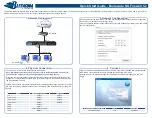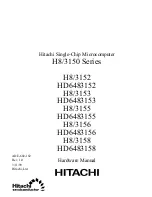
Architecture
842
SPRUH82C – April 2013 – Revised September 2016
Copyright © 2013–2016, Texas Instruments Incorporated
External Memory Interface A (EMIFA)
Table 19-9. Description of the SDRAM Timing Register (SDTIMR)
Parameter
Description
T_RFC
SDRAM Timing Parameters.
These fields configure the EMIFA to comply with the AC timing
requirements of the attached SDRAM devices. This allows the EMIFA to avoid violating SDRAM timing
constraints and to more efficiently schedule its operations. More details about each of these parameters
can be found in the register description in
. These parameters should be set to satisfy the
corresponding timing requirements found in the SDRAM's datasheet.
T_RP
T_RCD
T_WR
T_RAS
T_RC
T_RRD
Table 19-10. Description of the SDRAM Self Refresh Exit Timing Register (SDSRETR)
Parameter
Description
T_XS
Self Refresh Exit Parameter.
The T_XS field of this register informs the EMIFA about the minimum
number of EMA_CLK cycles required between exiting Self Refresh and issuing any command. This
parameter should be set to satisfy the t
XSR
value for the attached SDRAM device.
19.2.4.4 SDRAM Auto-Initialization Sequence
The EMIFA automatically performs an SDRAM initialization sequence, regardless of whether it is
interfaced to an SDRAM device, when either of the following two events occur:
•
The EMIFA comes out of reset. No memory accesses to the SDRAM and Asynchronous interfaces are
performed until this auto-initialization is complete.
•
A write is performed to any of the three least significant bytes of the SDRAM configuration register
(SDCR)
An SDRAM initialization sequence consists of the following steps:
1. If the initialization sequence is activated by a write to SDCR, and if any of the SDRAM banks are open,
the EMIFA issues a PRE command with EMA_A[10] held high to indicate all banks. This is done so
that the maximum ACTV to PRE timing for an SDRAM is not violated.
2. The EMIFA drives EMA_SDCKE high and begins continuously issuing NOP commands until eight
SDRAM refresh intervals have elapsed. An SDRAM refresh interval is equal to the value of the RR
field of SDRAM refresh control register (SDRCR), divided by the frequency of EMA_CLK (RR/f
EMA_CLK
).
This step is used to avoid violating the Power-up constraint of most SDRAM devices that requires
200
μ
s (sometimes 100
μ
s) between receiving stable Vdd and CLK and the issuing of a PRE
command. Depending on the frequency of EMA_CLK, this step may or may not be sufficient to avoid
violating the SDRAM constraint. See
for more information.
3. After the refresh intervals have elapsed, the EMIFA issues a PRE command with EMA_A[10] held high
to indicate all banks.
4. The EMIFA issues eight AUTO REFRESH commands.
5. The EMIFA issues the LMR command with the EMA_A[9:0] pins set as described in
6. Finally, the EMIFA performs a refresh cycle, which consists of the following steps:
(a) Issuing a PRE command with EMA_A[10] held high if any banks are open
(b) Issuing an REF command
















































